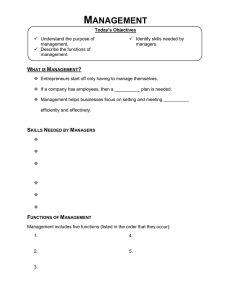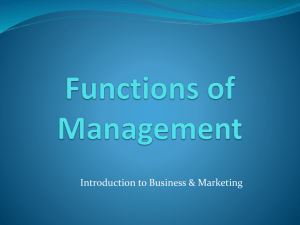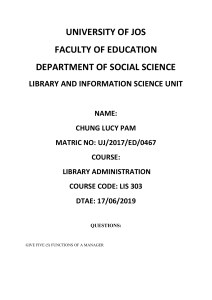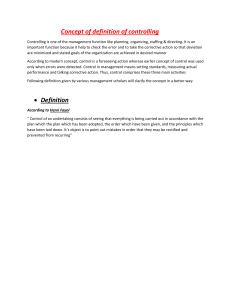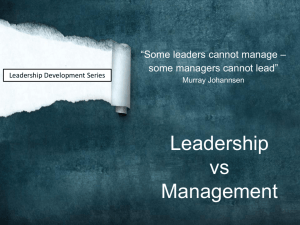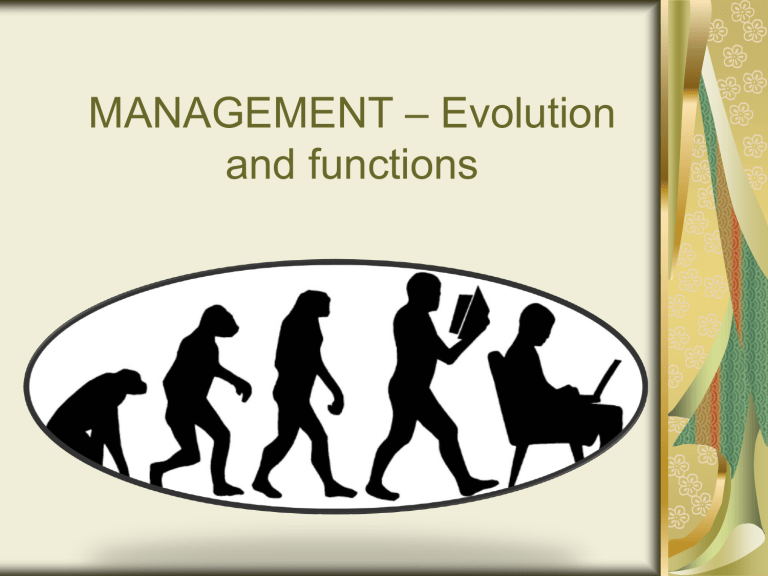
MANAGEMENT – Evolution and functions Management is an important element in every organization. It is the element that coordinates currents organizational activities and plans for the future. The management adapts the organization to its environment and shapes the organization to make it more suitable to the organization. Definition “Management is the art of “knowing what you want to do” and then seeing that it is done in the best and cheapest way. ……F.W.Taylor Management as a process “consisting of planning, organizing, actuating and controlling, performed to determine and accomplish the objective by the use of people and resources.” ……George R. Terry Planning means Plan in advance. Organizing means coordination between human resources and material resources. Actuating means motivation and giving direction to subordinate. Controlling means to ensure about implementation of plan without deviation. Thus management is act of achieving the organization objectives. MANAGEMENT FUNCTIONS OR THE PROCESS OF MANAGEMENT Planning, Organizing, Leading & Controlling (Newman & Summer) Planning, Organizing, Commanding, Coordinating and Controlling (Henri Fayol) ‘POSDCORB’: Planning, Organizing, Staffing, Directing, Coordinating, Reporting & Budgeting (Luther Gulick) Decision Making, Organizing, Staffing, Planning, Controlling, Communicating & Directing (Warren Haynes & Joseph Massie) Planning, Organizing, Staffing, Directing & Controlling (Koontz O’Donnell) Planning • It is a process of deciding the business objectives and charting out the plan/ method for achieving the same. • This includes determination of what is to be done, how, and where it is to be done, who will do it and how result are to be evaluated. • This function expected to be carried out throughout the organization. It should be performed by the manager at all levels. Organizing Organizing refers to “the structure which results from identifying and grouping the work, defining and delegating responsibility and authority and establishing relationships.” To organize a business is to provide it with everything useful to its functioning i.e. personnel, raw materials, machineries, capital etc. Once objectives are established, the manager has to develop a plan to achieve them with help of human resources as well as material resources. Directing Directing involves Communication - process of passing the information and understanding it from one person to other person. Leadership - the person or manager guides and influences the work of his subordinates. Motivation - to motivate the employee to give their best to the organization. Controlling The controlling involves1. Establishing standards of performance. 2. Measuring current performance and comparing it against the established standard. 3. Taking corrective action that does not meet the standard. Control compels the events to confirm to plans. Innovation and Representation Innovation means creating new ideas which may either result in the development of new products or finding new uses for older ones. It is necessary to grow better. The manager has to represent himself for the organization. A manager must win support effectively from different groups (either internal or external). LEVELS OF MANAGEMENT COMPANY PRESIDENTS, EXECUTIVES, VICE PRESIDENT TOP SALES MANAGERS, PERSONNEL MANAGERS, OTHER DEPARTMENTAL HEADS MIDDLE (FIRST LINE): FOREMEN & WHITE COLLAR SUPERVISOR LOWER MANAGERIAL SKILLS Top Management Middle Management Supervisory Level Conceptual Skills Human Relation Skill Technical Skills Evolution of Management Thought SCIENTIFIC MANAGEMENT THEORY Frederick W. Taylor Henry L. Gantt Frank and Lillian Gilbreth He also encouraged employers to pay more productive workers at a higher rate than others, using a "scientifically correct" rate that would benefit both company and worker. This system is called Differential Rate System Using time study as his base, he broke each job down into its components and designed the quickest and best methods of performing each component. Gantt originated a charting system for production scheduling. Administrative Management Theory Henri Fayol is the founder of the administrative management theory. Fayol believed that sound management practice falls into certain patterns that can be identified and analyzed. Fayol was interested in the Total Organization and focused on management, which he felt had been the most neglected of business operations. Behavioral Management Theory This theory puts more emphasis on individual’s attitudes, behaviors and on the group processes. In this approach of management human factor remain central focus. This approach can be studied into two phases – a. Human Relation Movement b. Behavioral Science Approach Major contributors to this approach were Elton Mayo, Abraham Maslow and Douglas McGregor Used as a general term to describe the ways in which managers interact with their employees. The human relations movement arose from early attempts to systematically discover the social and psychological factors that would create effective human relations. This approach aims at providing high degree of satisfaction and motivation through improved working conditions, style of supervision and sense of security. It provides important insights into motivation, leadership, group dynamics and other interpersonal process in organizations. System Approach Chester Barnard, George Homans, Herbert Simon etc. are the contributors in System Approach. This approach gives managers a way of looking at the organization as a whole and as a part of the larger, external environment. Systems theory tells us that the activity of any segment of an organization affects, in varying degrees, the activity of every other segment. It calls attention to the dynamic and interrelated nature of organizations and the management task. It provides a framework within which we can plan actions and anticipate both immediate and far-reaching consequences while allowing us to understand unanticipated consequences as they develop. A system is a set of interdependent parts – An organization is a system composed of four interdependent parts i.e. task, structure, people and technology. Contingency Approach The manager's task is to Identify which technique will, in a particular situation, under particular circumstances, and at particular time, best contribute to the attainment of management goals. Methods and techniques which are highly effective in one situation may not work in other situations. Results differs with situational difference.



